Eckhard Bick
PORTUGUESE SYNTAX
8. Co-ordination
A constituent that consists of 2 or more co-ordinated constituents, is called a paratagma or, with an English expression, co-ordinated unit (cu) cu is a form category, like word, group and clause. Usually, co-ordinated constituents have the same form, i.e. 2 np's, 2 adjectives, 2 predicators etc., and are co-ordinated by 1 or more co-ordinators (CO) . Coordinator function is usually filled by co-ordinating conjunctions (conj-c: e, ou, mas), but punctuation (commas, slashes) - if allowed in the tagging scheme - can also do the job. The individual co-ordinated constituents are assigned the dummy function of conjunct (CJT) with regard to their mother constituent, the cu, and their "real" outward function is lost to the cu, which "represents" them on the next higher syntactic level. Thus, in a constituent grammar analysis of the sentence

it is not the conjuncts (in italics), that function as subjects, but the co-ordinated unit as a whole (underlined). Note that e and the comma both fulfil the same function (CO).
Not only words, but groups and clauses can be co-ordinated, too, and in principle, any combination of forms is possible:

Note that the first two conjuncts could also have been tagged as words (CJT:v-fin), not clauses, without disturbing the conjunction mechanism, since conjuncts need not share the same form.

Note that the pp de e sobre crianças does not have a simple preposition as head, but a compound unit consisting of co-ordinated prepositions. Since we have so far defined groups by prototypical head forms (and prototypical dependent functions), we must now widen this definition accordingly, providing for complex head cu's with prototypical head forms as conjuncts. In doing so we gain the notational bonus of not needing a zero constituent DP (italicized) after de only to create matching pp-conjuncts (?de crianças e sobre crianças).

Co-ordination is one of the possible causes of syntactic ambiguity. For example, postnominal adjectives may be attached before or after co-ordination, as in the following case of true ambiguity:
(a)

(b)

In (a), the nouns are co-ordinated first, and function as a complex head (H:cu) for the adjective postmodifier (DN:adj). In (b), the first noun is co-ordinated with an np that has already integrated the adjective postmodifier.
In a flat CG dependency notation (c), this ambiguity can be underspecified and expressed in one analysis:

Here, the postnominal tag (N<) points left to a nominal head, but underspecifies whether this head is a single noun (guerras), or 2 co-ordinated nouns (secas e guerras).
Semantically, co-ordinations come as con-junctions (e, nem) , dis-junctions (ou ... ou, quer ... quer, ora ... ora) and contra-junctions (mas). In the case of dis-juncting (blue), there is one additional coordinator, as a kind of "left bracket" for the cu, while con-juncting (yellow) may work even without a lexical coordinator:
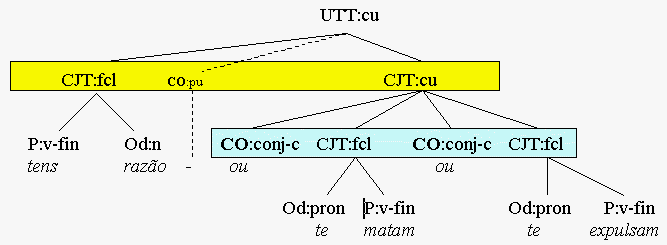
Sometimes, co-ordinating conjunctions introduce a main clause:
a: E leva teu irmão!
Rather than operating with "defect" co-ordinated units, with only one conjunct, one might choose to regard e in this sentence as a clause level constituent, either as CO (coordinator) or - if we want to avoid the CO function outside cu's - as fA (adverbial):

Consider also:
b: Chovia muito, e não queríamos sair.
As a matter of fact, the function of the co-ordinating conjunctions in (a,b) closely resembles that of "conjunctional adverbs" or "conjunctional adverbial expressions" that sequentially link statements in a kind of co-ordinated nexus of continuation (apesar
disso), consequence (pois, por isso, eis porque, consequentemente),
concession (ainda assim, ainda mesmo, apesar disso, nada obstante,
no entanto) or contrast (porém, todavia).
Thus, e in (a) can
be substituted by apesar disso, while e in (b) expresses consequence
and could be replaced by por isso or consequentemente. Likewise, sentence-initial
mas is an analogue of the adverbial expression apesar disso.
This functional and
semantic resemblance between certain conjunctions and adverbs supports
a clause-level analysis of e in the above cases, as for the corresponding
adverbs. Next, we must choose a function tag, CO (the natural for conjunctions)
or fA (the natural for adverbs). On the one hand, using CO:adv for "conjunctional
adverbs" has the advantage of preserving both "conjunctionality" (as function)
and "adverbiality" (as form). On the other hand, using fA:conj-c for a
clause level e that has no conjuncts to conjunct, seems useful, too -
and we avoid using a paratagma level function on clause level.
Co-ordination is a
way of streamlining the syntax of an utterance, since (co-ordinated) groups
of constituents share their functional relation to other constituents,
which therefore need not appear twice in the clause:
In the CG-notation, there are 2 direct objects (ACC) and 2 prepositional
objects (PIV) attaching left (<) to 1 main verb (MV), and since the
syntactic notation is "flat", the lone co-ordinator (CO) can elegantly
serve all 4 objects without specifying cu-constituent boundaries. Constituent
boundaries are, however, necessary in a syntactic tree for the same sentence,
creating problems as to which function to assign to the resulting co-ordinating
unit (?:cu), and what form to the conjuncts (CJT:?), since we do not have
a function term for a nexus between direct and prepositional object, nor
a form category for unco-ordinated juxtaposed np's and pp's, or, for that
matter, pronouns and pp's:
One possibility is
to let the analysis stand as it is - with question marks. This is the solution
adopted in Carl Bache's stacking approach in "Presentation of a
pedagogical sentence analysis system" (in Hermes, Journal of Linguistics,
17, 1996), where X is used as a function stack, and x as a form stack,
each stack postponing "real" analysis to a lower - more analytic
- level in the tree.
Another solution is
to "clone" that or those constituents (in the shape of zero-constituents)
, that have been economized by the co-ordination in the first place.
In this case, that would mean adding a zero-constituent predicator (doou)
after the co-ordinator (e):
This way, only "established"
forms (here, fcl's) are co-ordinated, and the cu itself has a "real" function,
that of statement (STA).
A third solution would
be to abolish the category of co-ordinated units altogether, define co-ordinators
as clause- or group-level constituents, and - in the given sentence - opt
for a CG-like, flat analysis on the clause level:
In the Portuguese VISL
system, zero constituents are avoided, both for pedagogical reasons (i
many cases it isn't even obvious where to add a zero constituent nor what
the concerning "invisible" word should be), and because Constraint Grammar
based systems of automatic analysis need "real" words for their form and
function tags.
In the analysis of
compound units we will therefore create conjuncts as they appear at the
syntactic surface - even where this method results in undefined
conjunct forms or compound unit functions (as shown in the first analysis).
In practice, question
mark tags (or stacks) are rarely needed. Rather, some pre-existing
category will offer itself for deeper insight. Take, for example, co-ordination
after auxiliaries, providing evidence for the independent existence of
the category AUX< (auxiliary complement), as used in the Portuguese
and English VISL CG:
A Ásia deve
manter o seu nível de internacionalização e criar
um mercado comum.
Another example is
the SUB< constituent (clause body) , which
was introduced in the CG analysis for the analysis of averbal sentences,
but comes handy in co-ordination, too:
Se morássemos
na África e tivéssemos dinheiro, te compraria um hipopotamozinho.

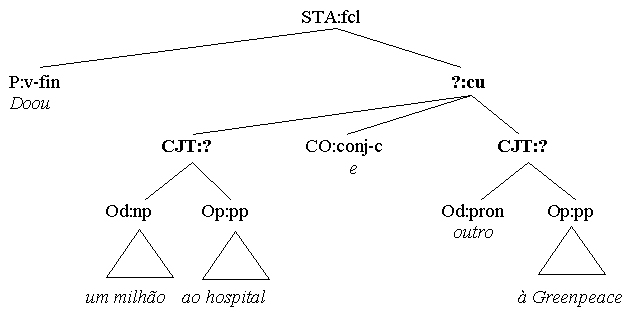
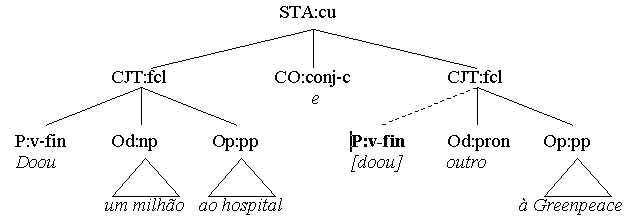

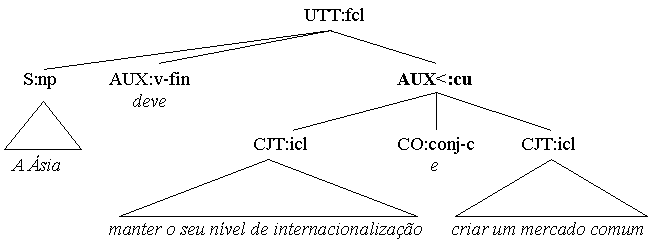
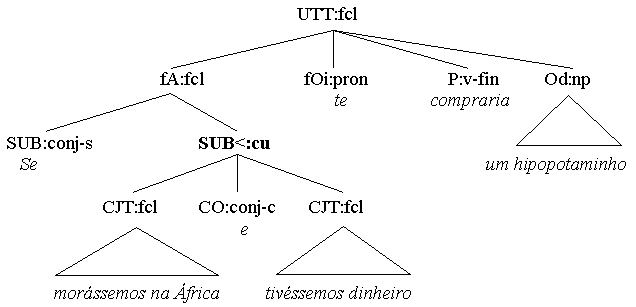
symbol
category
CO
coordinator
coordenador
koordinator
CJT
conjunct
(elemento) conjunto
konjunkt
cu
compound
unit
paratagma
paratagme